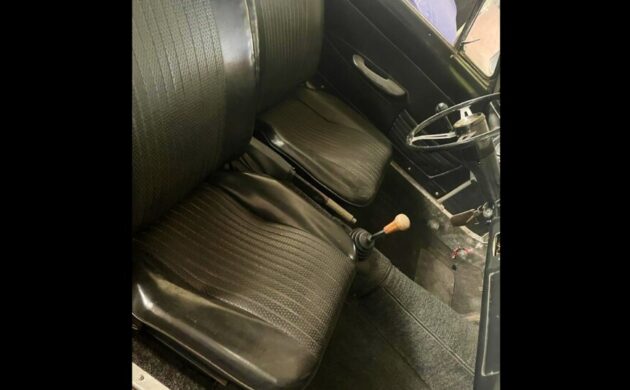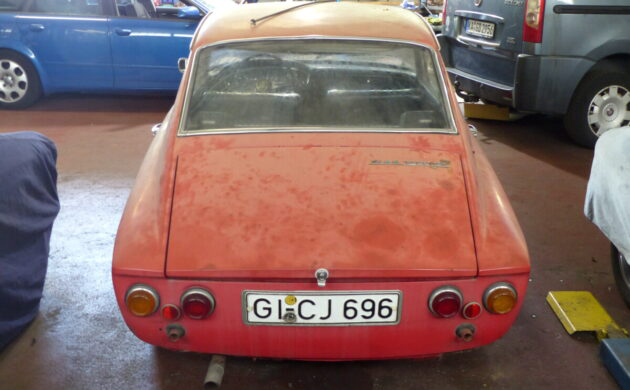Italian from Germany: 1966 Glas 1300 GT Coupe
Before mass production, acrobatic relationships among automaker, designer, and coach builder were commonplace. Sometimes the designer and coach builder were the same; sometimes not. Sometimes the coach builder built the whole car; sometimes it shipped bodies to the automaker for final assembly. Sometimes the designer was in-house at the maker; sometimes the designer left in a huff to join the coach builder. Understanding these relationships helps unlock the “why” and “who” of automotive history. Why does a car look this way? Those two cars from different makers look a lot alike; who designed them? Our subject car offers a tidy study of these relationships. Here at Car & Classic is a 1966 Glas 1300 GT coupe project, with an asking price of €19,999, located in Ettlingen, Germany. This fine tip comes to us courtesy of Kyle K. – thanks, Kyle!
Hans Glas GmbH was founded in 1860 to make and maintain agricultural machinery, an enterprise that served the family well for decades. Its factory in Dingolfing, Germany had to shift production to munitions during WWII. But better things were in store: Andreas Glas, on a trip to Verona, Italy, became enamored of the ubiquitous Vespa, and after the war, created the Goggo, and its microcar successor, the Goggomobile. Glas moved from microcars to simply very tiny cars with the T600, then up the scale to “small” with the homely 1004 and its ilk – designed internally and not, unfortunately, terribly successful. By now, Glas was feeling the heat of competition too keenly. It contracted with Frua to design the 1300 GT, though the bodies were actually built by Maggiora (of Alfa Romeo 2000 and Maserati Mistral fame, among many others), in Turin. The bodies were returned to Glas for assembly; all this handling was expensive which figured later in Glas’ fortunes. Meanwhile, the car’s mechanicals benefited from the ministrations of engineer Leonhard Ischinger who joined Glas from BMW. Ischinger invented the toothed cam belt, a form of which resides in this 1290 cc four-cylinder marvel. With twin Solex carburetors, an aluminum head, hemispherical combustion chambers, and a 9.3:1 compression ratio, the output is 85 hp. Rowing through the four-speed manual can bring the car past 100 mph. Our seller says this engine runs, but notes the brakes need rebuilding after the car’s long slumber. The odometer reads just 2442 km.
The interior is well equipped for such a small car. While the front of the cabin needs help, the rear seats are characteristically excellent – since no one uses them. The dash is magnificent – the Italianesque three-spoke steering wheel, the abundance of gauges (I am a gauge nut), the delicate switches. Even the door panel design screams “Italian”!
The rear bumper is missing, and the seller notes that the sills need replacing. Comparable sales are difficult to find, but this one failed to sell after a bid of $9500, though it was located in the Netherlands and trying to sell in the US. This one was sold in Europe from the magnificent Petitjean collection (a treat to peruse) at €15,950. Meanwhile, let’s put this price into a different perspective: Glas was taken over by BMW in 1966, continuing for a time the relationship with Frua. One child of this marriage was the wonderful BMW 1600 GT by Frua, a car that can easily sell for six figures!
Auctions Ending Soon
 2002 Subaru Impreza WRXBid Now1 days$333
2002 Subaru Impreza WRXBid Now1 days$333
 1975 Chevrolet Corvette ConvertibleBid Now1 days$4,000
1975 Chevrolet Corvette ConvertibleBid Now1 days$4,000
 1964 Ford F-100 Camper CustomBid Now1 days$2,000
1964 Ford F-100 Camper CustomBid Now1 days$2,000
 2006 Jeep Wrangler SportBid Now3 days$11,000
2006 Jeep Wrangler SportBid Now3 days$11,000
 1974 Datsun 260ZBid Now5 days$750
1974 Datsun 260ZBid Now5 days$750





Comments
Thank you Michelle for tying this all together. I tried in the past when I was intrigued by Frua’s designs. Beautiful design and it’s a shame BMW didn’t let that manufacturer keep its autonomy as a small car manufacturer. Kind of like Mini is to BMW.
I have only seen one of these in real life and the design when seen live is far more elegant than it looks in these photos. I am not away of what the pricing was but I expect it was costly for this is far too pretty a car not to have sold better if it were more price competitive.
I suspect that the sills would be not too serious to fix properly as the are almost straight metal bent as required. This could be a very fun restoration and would be a economic one as well for with that horsepower and engine size it had to get pretty good milage. I hope it finds a good home and get restored properly. Like beautiful women there are not enough beautiful cars on the road at any time.
At first glance, I thought it was a Pinto (front view), then the rear reminded me of the Opel…. I’ll pass on this one.. lol, but then I’m old too !!
Poor fellow. You must be sight challenged.
Nope, just what popped into my mind when I first looked at it…. sight is ok, I’ve had cataract surgery lol
plus there is an old saying “your perception is your reality”… my reality and my perception was as stated above… sorta like some guys like a blonde haired woman, another likes a redhead, and others go for brunettes….
Just curious, OR, what kind of cars do you like?
Not sure what it would cost to get that thing shipped to rural Idaho but then there is finding parts, I would have to set about finding a rear wheel drive Toyota or Honda for a parts car and modify suspension to something you can actually get at O’REILLY
Best don’t.
In 1967 I bought a new Glas 1700GT from a dealer in Belmont Ca. The handling was a bit quirky, but after getting used to it outrunning Porsche 912´s or Alfa Spyders, MG´s and Triumphs was no problem. Spacious interior comfortable seats, flat and spacioius trunk, a dashboard to drool over replete with every VDO gauge imaginable, this machine was truly a dream. I sold it sometimes in the middle ´70´s, to my everlasting regret and replaced it with a nightmare on wheels, Maserati 3500 GT In 1985 I spied a BMW 1600 GT in a German sports car journal for sale in Mannheim and bought it, sight unsseen, shipped it to LA and discovered to my dismay that the car was a rust bucket underneath its nice paint. Especially the area underneath the rear seat and the lower doors were afflicted. I spent tons of money trying to correct the problem, alas to no avail. The problem was, the rear flop out windows and the trunk lid were not watertight. The bottom of the doors accumulated water as well. I widened the fenders front and rear, installed low profile Michelins on chromned mag wheels and painted the car Italian red – heck it was gorgeous, alas the tin wurm problem was untamed. I sold it at a Kruse auction for peanuts. BEWARE of any car from Germany – they are all inherently rust buckets due to the salt being used on wintertime roads.
Wow I have never seen one of these and I love it no clue what the exchange rate would make the cost being in banking I probably should know that but in Commercial RE don’t deal with it
Wish I could find one in SE for reasonable $ might sell one of my El caminos or fiat spyders for one
Yes, I have in Ca. a Barn Finds 1700GT I bought 15 years ago. Good Lord willing I will complete the restoration by adding Weber carbs.. I did drive her years ago with the original carbs which did not have floats on the carb but mounted on the cars frame rail. Stopped driving it for fire fear.
Now the Glas Club of Germany, a great group of dedicated Glas enthusiasts , where parts and advice are readily available.
A good advice of Gerard F. about rust. Anytime I hear a car from East US, I shy away for a fear of Rust. ‘Did not know this was true also of Deutchland.
Epecially cars whose bodies were manufactured in Italy. The Italians clearly have never heard of rust proving.
What is rust proving?
a sunny Itilian beauty does not belong in cold northern chermny anyway. (they belong right here @ my house aahahaha
Author a trifle Rand-y for these cars ?
Jwaltb rust is proving Italians can’t build a car that doesn’t disintegrate LOL